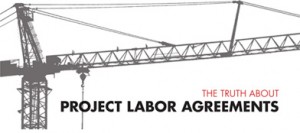 Labor Relations INK In this issue:
Labor Relations INK In this issue:
- Union Bailout Update
- Wisconsin Fallout
- Us vs. Them: Why Unions Make Workers Unhappy
- The Battle Over PLAs Heats Up
- Scoreboard, SEIU Watch, Sticky Fingers and more…
Union Bailout Update  It’s been a busy week in Washington for both sides of the fight over workers’ and employers’ rights in remaining union free. In our March 11 issue of INK we mentioned Senator Jim DeMint had introduced a national Right-To-Work bill certain to fail in the Senate. On March 14, Rep. Phil Roe (R-TN) reintroduced the Secret Ballot Protection Act (H.R.972) in the House of Representatives, legislation that would amend the NLRA to guarantee the right to secret ballot union representation elections. On March 21 that bill was referred to the Subcommittee on Health, Employment, Labor, and Pensions. H.R. 1047 was also sent to the Labor subcommittee after being introduced on March 11 by freshman Rep. Jeff Duncan (R-SC). H.R. 1047 would amend the NLRA to protect state requirements for secret ballot elections. The bill already has 27 cosponsors. This is the latest volley in the battle between the NLRB and Utah, South Carolina, Arizona and South Dakota, states where voters have protected their right to secret ballot elections in their state constitutions. Meanwhile, the Missouri House voted last week to become the fifth state to require secret ballot union elections. (Learn more about the NLRB vs. State Rights in the February 25 issue of INK.) Members of the same subcommittee are also still investigating the NLRB’s use of free Google ad space to engage in blatant union solicitation. Meanwhile, over at the Department of Labor, as we reported last week they’ve launched a new website to elicit suggestions on regulatory policy and processes in response to an Executive Order calling for government-wide regulatory review. Unfortunately, the DOL hasn’t been quite as compliant with another EO, the Open Government Directive, and its demand for transparency in government. While the DOL created a searchable enforcement database to publicly out all corporate evildoers, it also practiced a little union-friendly selective transparency in not granting access to union corruption data from the OLMS. As a matter of fact, the DOL searchable database includes no data from OLMS. And seeing as OLMS is solely responsible for enforcing Landrum-Griffin, we find this omission both curious and infuriating. Finally, over at the Becker NLRB, the union lovin’ decisions just keep on comin’! The NLRB has rejected a call from the Hyatt Regency Indianapolis to end over a year of harassment by UNITEHERE and give their employees the opportunity to have their voices heard in an NLRB election. It appears the only way an employer can stop union harassment (short of RICO – more on that later) is to give in to union demands for recognition regardless of how few employees support the union. The Becker Board has also granted union cultists and shop floor thugs the freedom to assault, threaten and harass their anti-union or undecided coworkers during elections and card drives, just as long as those committing the actual felonies aren’t officially appointed by the union to do so. In handing down its stunning decision on Mastec North America and Communications Workers of America, the Becker Board made clear that union members are actually “third parties” (so much for “the Union is You!”) unless they hold a title given by the union regardless of how much time they spend organizing for the union and smoozing around with union staff. Thus intimidation by these “third parties” is not cause to overturn an election even when the number of victims is larger than the margin of union victory. In his brilliant dissent to the decision, Member Hayes wrote “One of the principal reasons for finding many third party threats unobjectionable is that the protagonists are not in a position to make good on the threat. That rationale is applicable to many types of threats to affect an employee’s job or working conditions, but it hardly holds true for threats of a physical nature. Unless the Board is going to impose on an objecting party the burden to prove that an employee making a threat has greater pugilistic skills or physical prowess than the threatened employee, and it has not heretofore imposed such a burden, then it seems an acceptable general proposition that third parties making physical threats are capable of following through on them.” ********** Wisconsin Fallout
It’s been a busy week in Washington for both sides of the fight over workers’ and employers’ rights in remaining union free. In our March 11 issue of INK we mentioned Senator Jim DeMint had introduced a national Right-To-Work bill certain to fail in the Senate. On March 14, Rep. Phil Roe (R-TN) reintroduced the Secret Ballot Protection Act (H.R.972) in the House of Representatives, legislation that would amend the NLRA to guarantee the right to secret ballot union representation elections. On March 21 that bill was referred to the Subcommittee on Health, Employment, Labor, and Pensions. H.R. 1047 was also sent to the Labor subcommittee after being introduced on March 11 by freshman Rep. Jeff Duncan (R-SC). H.R. 1047 would amend the NLRA to protect state requirements for secret ballot elections. The bill already has 27 cosponsors. This is the latest volley in the battle between the NLRB and Utah, South Carolina, Arizona and South Dakota, states where voters have protected their right to secret ballot elections in their state constitutions. Meanwhile, the Missouri House voted last week to become the fifth state to require secret ballot union elections. (Learn more about the NLRB vs. State Rights in the February 25 issue of INK.) Members of the same subcommittee are also still investigating the NLRB’s use of free Google ad space to engage in blatant union solicitation. Meanwhile, over at the Department of Labor, as we reported last week they’ve launched a new website to elicit suggestions on regulatory policy and processes in response to an Executive Order calling for government-wide regulatory review. Unfortunately, the DOL hasn’t been quite as compliant with another EO, the Open Government Directive, and its demand for transparency in government. While the DOL created a searchable enforcement database to publicly out all corporate evildoers, it also practiced a little union-friendly selective transparency in not granting access to union corruption data from the OLMS. As a matter of fact, the DOL searchable database includes no data from OLMS. And seeing as OLMS is solely responsible for enforcing Landrum-Griffin, we find this omission both curious and infuriating. Finally, over at the Becker NLRB, the union lovin’ decisions just keep on comin’! The NLRB has rejected a call from the Hyatt Regency Indianapolis to end over a year of harassment by UNITEHERE and give their employees the opportunity to have their voices heard in an NLRB election. It appears the only way an employer can stop union harassment (short of RICO – more on that later) is to give in to union demands for recognition regardless of how few employees support the union. The Becker Board has also granted union cultists and shop floor thugs the freedom to assault, threaten and harass their anti-union or undecided coworkers during elections and card drives, just as long as those committing the actual felonies aren’t officially appointed by the union to do so. In handing down its stunning decision on Mastec North America and Communications Workers of America, the Becker Board made clear that union members are actually “third parties” (so much for “the Union is You!”) unless they hold a title given by the union regardless of how much time they spend organizing for the union and smoozing around with union staff. Thus intimidation by these “third parties” is not cause to overturn an election even when the number of victims is larger than the margin of union victory. In his brilliant dissent to the decision, Member Hayes wrote “One of the principal reasons for finding many third party threats unobjectionable is that the protagonists are not in a position to make good on the threat. That rationale is applicable to many types of threats to affect an employee’s job or working conditions, but it hardly holds true for threats of a physical nature. Unless the Board is going to impose on an objecting party the burden to prove that an employee making a threat has greater pugilistic skills or physical prowess than the threatened employee, and it has not heretofore imposed such a burden, then it seems an acceptable general proposition that third parties making physical threats are capable of following through on them.” ********** Wisconsin Fallout  As we predicted in the March 11 issue of INK labor unions are hard at work trying to turn their moment into a movement. The always trustworthy Huffington Post reports that Working America, the AFL-CIO advocacy group for all the rest of us, signed up 20,000 new members between February and March 15. Working America claims to offer many of the same benefits of belonging to a union (dues, class warfare, the chance to be a part of overthrowing our economic system) without being forced to endure a democratic election or the annoyance of a union contract. Meanwhile the AFL-CIO is calling for teach-ins and other job actions on April 4, the anniversary of the assassination of Martin Luther King because it’s “a day to stand in solidarity with working people in Wisconsin and dozens of other states where corporate-bought politicians are trying to take away the rights Dr. King gave his life for.” (Wow.) They are also calling for a “not-business-as-usual” Nationwide Day of Action at workplaces and communities across the country in support of labor rights. In approving the plan of action, the AFL-CIO Executive Board urged “movement-wide dramatic actions” on that day. We are on the edges of our seats. It seems the entire labor movement (and friends) is shifting towards this new shtick of “collective bargaining as a basic human right” first pushed to the front pages by Bob King earlier this year when he demanded foreign automakers adopt the UAW’s “ground rules” or be labeled “human rights violators.” This approach is the brainchild of Richard Bensinger, the new UAW organizing director, and it reinforces the narrative of the reasonable Ghandi-esque labor leaders versus the tyrannical Gaddafi-like corporate overlords. At an Emergency Labor Meeting in Cleveland on March 5, ninety-six such rights lovin’ union leaders from twenty-six states adopted fifteen “Perspectives” that expand on Bob’s “ground rules” and read in large part like a Marx manifesto. Principle Four quite officiously invokes the (shudder) United Nations and (what’s this??) puts the United States on trial. “The right to collective bargaining is a right enshrined in universally recognized Conventions 87 and 98 of the UN-based International Labor Organization; it is also a human right codified in the UN Charter. In fact, the United States is on trial before world public opinion for violating basic labor rights at home.” In addition to calling for street fighting and the end of all Right to Work laws as “human rights violations” the Principles also call for the government to take over the role of creating jobs from the private sector and the strengthening of the “social insurance model” including food stamps and Medicaid for all. Back to Wisconsin. Two interesting fun facts have emerged since the end of hostilities. First, as it turns out, the son of Judge Maryann Sumi is a former field manager for the state AFL-CIO and data manager for SEIU who now runs his own leftwing organizing firm. His mother, Judge Sumi, issued the temporary restraining order that stopped implementation of the Wisconsin’s new law governing public sector unionism. Surprised? And we all remember Wisconsin protestors blowing around about how the entire Wisconsin electorate stood behind them and not Gov. Walker in defense of their God given inalienable right to forcibly collect dues and coerce their wages and mega-benefits out of beholdin’ politicians. Well, turns out they were wrong about that too. (Surprised?) An analysis by the non-partisan Wisconsin Center for Investigative Journalism found that of the 50,000 plus emails that flooded the governor’s office during the Madison standoff, 85% of out-of-state emailers supported Governor Walker as did 55% of Wisconsites. Finally, it’s not all doom and gloom at the state house level for organized labor. The Connecticut legislature is considering a bill to expand the reach of public employee unions to most salaried employees and graduate assistants. A second bill promoted by SEIU (surprised?) would recreate the scam that forcibly unionized day care and home care private providers in Michigan, California, Oregon, Illinois and Massachusetts. Both UConn and the state’s director of labor relations Linda Yelmini have strenuously objected to the bills. The result would be that at least 99.5 percent of classified state employees would be eligible to unionize. “Under this bill, the balance between labor and management would be permanently modified with the taxpayers, clients and other citizen groups being shortchanged,” Yelmini said in testimony submitted to the committee. “Management and labor would be on the same side of the table,” Yelmini said. “Bureau heads could not be expected to manage entire agencies alone.” *********** SCORE BOARD
As we predicted in the March 11 issue of INK labor unions are hard at work trying to turn their moment into a movement. The always trustworthy Huffington Post reports that Working America, the AFL-CIO advocacy group for all the rest of us, signed up 20,000 new members between February and March 15. Working America claims to offer many of the same benefits of belonging to a union (dues, class warfare, the chance to be a part of overthrowing our economic system) without being forced to endure a democratic election or the annoyance of a union contract. Meanwhile the AFL-CIO is calling for teach-ins and other job actions on April 4, the anniversary of the assassination of Martin Luther King because it’s “a day to stand in solidarity with working people in Wisconsin and dozens of other states where corporate-bought politicians are trying to take away the rights Dr. King gave his life for.” (Wow.) They are also calling for a “not-business-as-usual” Nationwide Day of Action at workplaces and communities across the country in support of labor rights. In approving the plan of action, the AFL-CIO Executive Board urged “movement-wide dramatic actions” on that day. We are on the edges of our seats. It seems the entire labor movement (and friends) is shifting towards this new shtick of “collective bargaining as a basic human right” first pushed to the front pages by Bob King earlier this year when he demanded foreign automakers adopt the UAW’s “ground rules” or be labeled “human rights violators.” This approach is the brainchild of Richard Bensinger, the new UAW organizing director, and it reinforces the narrative of the reasonable Ghandi-esque labor leaders versus the tyrannical Gaddafi-like corporate overlords. At an Emergency Labor Meeting in Cleveland on March 5, ninety-six such rights lovin’ union leaders from twenty-six states adopted fifteen “Perspectives” that expand on Bob’s “ground rules” and read in large part like a Marx manifesto. Principle Four quite officiously invokes the (shudder) United Nations and (what’s this??) puts the United States on trial. “The right to collective bargaining is a right enshrined in universally recognized Conventions 87 and 98 of the UN-based International Labor Organization; it is also a human right codified in the UN Charter. In fact, the United States is on trial before world public opinion for violating basic labor rights at home.” In addition to calling for street fighting and the end of all Right to Work laws as “human rights violations” the Principles also call for the government to take over the role of creating jobs from the private sector and the strengthening of the “social insurance model” including food stamps and Medicaid for all. Back to Wisconsin. Two interesting fun facts have emerged since the end of hostilities. First, as it turns out, the son of Judge Maryann Sumi is a former field manager for the state AFL-CIO and data manager for SEIU who now runs his own leftwing organizing firm. His mother, Judge Sumi, issued the temporary restraining order that stopped implementation of the Wisconsin’s new law governing public sector unionism. Surprised? And we all remember Wisconsin protestors blowing around about how the entire Wisconsin electorate stood behind them and not Gov. Walker in defense of their God given inalienable right to forcibly collect dues and coerce their wages and mega-benefits out of beholdin’ politicians. Well, turns out they were wrong about that too. (Surprised?) An analysis by the non-partisan Wisconsin Center for Investigative Journalism found that of the 50,000 plus emails that flooded the governor’s office during the Madison standoff, 85% of out-of-state emailers supported Governor Walker as did 55% of Wisconsites. Finally, it’s not all doom and gloom at the state house level for organized labor. The Connecticut legislature is considering a bill to expand the reach of public employee unions to most salaried employees and graduate assistants. A second bill promoted by SEIU (surprised?) would recreate the scam that forcibly unionized day care and home care private providers in Michigan, California, Oregon, Illinois and Massachusetts. Both UConn and the state’s director of labor relations Linda Yelmini have strenuously objected to the bills. The result would be that at least 99.5 percent of classified state employees would be eligible to unionize. “Under this bill, the balance between labor and management would be permanently modified with the taxpayers, clients and other citizen groups being shortchanged,” Yelmini said in testimony submitted to the committee. “Management and labor would be on the same side of the table,” Yelmini said. “Bureau heads could not be expected to manage entire agencies alone.” *********** SCORE BOARD  Who are the winners (and losers) of the labor movement? Don’t guess, just check the LRI Scoreboard
Who are the winners (and losers) of the labor movement? Don’t guess, just check the LRI Scoreboard
View this month’s scoreboard (archives also located here).
Download a PDF of this month’s scoreboard
**********
The Impact of State Employment Policies on Job Growth: A 50 State Review
 The U.S. Chamber of Commerce has issued a report on job growth as it relates to state employment policies. You can also follow their webcast on the report. The study measures the burden of state regulations that exceed or overlap Federal regulations and the effect of a second layer of bureaucracy on job creation. More laws are not only more costly for employers to navigate they also provide more opportunities for costly litigation. The study weighs the costs, state by state, for minimum wage and “living wage” laws in excess of the Federal minimum, the cost of employment separation and workman’s comp, wage and hour policies and collective bargaining issues including Right to Work. ********** The States with the Strongest and Weakest Unions
The U.S. Chamber of Commerce has issued a report on job growth as it relates to state employment policies. You can also follow their webcast on the report. The study measures the burden of state regulations that exceed or overlap Federal regulations and the effect of a second layer of bureaucracy on job creation. More laws are not only more costly for employers to navigate they also provide more opportunities for costly litigation. The study weighs the costs, state by state, for minimum wage and “living wage” laws in excess of the Federal minimum, the cost of employment separation and workman’s comp, wage and hour policies and collective bargaining issues including Right to Work. ********** The States with the Strongest and Weakest Unions  Market Watch lists the top and bottom ten states for union strength based on membership, density, coverage and employment. Below is the list – check out the article for details: The 10 states with the strongest unions: 10. Oregon 9. Rhode Island 8. Michigan 7. Connecticut 6. New Jersey 5. California 4. Washington 3. Hawaii 2. Alaska 1. New York ********** Us vs. Them: Why Unions Make Workers Unhappy
Market Watch lists the top and bottom ten states for union strength based on membership, density, coverage and employment. Below is the list – check out the article for details: The 10 states with the strongest unions: 10. Oregon 9. Rhode Island 8. Michigan 7. Connecticut 6. New Jersey 5. California 4. Washington 3. Hawaii 2. Alaska 1. New York ********** Us vs. Them: Why Unions Make Workers Unhappy  A recent Gallup study shows lower overall job satisfaction for unionized workers due primarily to the sense of division and hierarchy in the workplace. The study was based on 149,514 interviews of union and non-union workers in the public and private sectors. The Gallup Healthways Work Environment Index questions were designed to test for certain factors shown to relate directly to various desirable business outcomes, including customer engagement, turnover, absenteeism, and productivity. The study thus suggests unionized workers’ may be far less engaged with their jobs than non-unionized workers. “The research shows that union workers are more likely than nonunion workers to consider their supervisor a “boss” rather than a “partner,” and less likely to believe their supervisor creates a trusting and open environment. It is not known whether certain types of workers who view supervisors in these ways are more likely to seek unionized jobs, or whether a unionized work setting changes the ways in which workers and supervisors relate. Nevertheless, the relationships show in general that, even after controlling for relevant demographic and geographic variables, workers who are members of unions score lower on the Gallup-Healthways Work Environment Index, which could have a bearing on overall employee performance in those settings.” Unionists might argue that unions are more prevalent in industries and to employers that typically suffer from bad management. However, given the current low union density it hardly seems likely that unions have somehow cornered the market on poor employee relations. We offer a third more plausible explanation for this phenomenon, far more likely than non-trusting employees seek union jobs or bad managers draw unions to them – unions promote division and mistrust in the workplace. (And frankly, we’re shocked this didn’t occur to Gallup!) And, if nothing else, the past month of union theater in state capitals across the Rust Belt should have reminded us all how unionists demonize anyone black-hearted enough to run a business, make a profit, balance a budget or manage others for a living. For just one of ten thousand examples, SEIU is promoting Take Em’ Down, a song by Dropkick Murphy, as the new battle cry of organized labor. “when the boss comes callin’ they’ll put us down when the boss comes callin’ gotta stand your ground when the boss comes callin’ don’t believe their lies when the boss comes callin’ his take his toll when the boss comes callin’ don’t you sell your soul when the boss comes callin’ we gotta organize let em know we gotta take the bastards down let them know we gotta smash them to the ground let em know we gotta take the bastards down” But it’s far deeper than Madison. Division of the workplace is the driving principle, the mantra, the bedrock, the lifeblood of organized labor. And in its absolutism it leaves no wiggle room for good bosses, generous bosses or bosses who care for their employees, let alone true teamwork. 21st century unionists still lock arms and weep while howling century old anthems to class warfare like Which Side Are You On (“Don’t scab for the bosses, Don’t listen to their lies. Us poor folks haven’t got a chance Unless we organize.) and Solidarity Forever (“Is there aught we hold in common with the greedy parasite, Who would lash us into serfdom and would crush us with his might? Is there anything left to us but to organize and fight?”) And just two weeks ago Joe Biden told labor leaders they were “the only people who have the capacity — organizational capacity and muscle — to keep… the barbarians from the gate.” So why would a unionized worker, bombarded with divisive messaging from the union newsletter and expected to, above all else (and under penalty of ostracism or worse) stay loyal to his “Brothers and Sisters” over “The Boss,” work cooperatively with management, trust the company or love his or her job? By union logic the unionized worker is patently NEVER paid enough, respected enough or valued enough because by definition the employer is intrinsically inescapably untrustworthy and cheap. By its very nature unionization demands a worker not trust his boss and come to work feeling perpetually underpaid, overworked and underappreciated by managers out to do nothing but screw him. That just might explain why Gallup is finding these folks “less engaged” with their jobs. ********* Canadian Walmart Workers Hope to Show Union the Door
A recent Gallup study shows lower overall job satisfaction for unionized workers due primarily to the sense of division and hierarchy in the workplace. The study was based on 149,514 interviews of union and non-union workers in the public and private sectors. The Gallup Healthways Work Environment Index questions were designed to test for certain factors shown to relate directly to various desirable business outcomes, including customer engagement, turnover, absenteeism, and productivity. The study thus suggests unionized workers’ may be far less engaged with their jobs than non-unionized workers. “The research shows that union workers are more likely than nonunion workers to consider their supervisor a “boss” rather than a “partner,” and less likely to believe their supervisor creates a trusting and open environment. It is not known whether certain types of workers who view supervisors in these ways are more likely to seek unionized jobs, or whether a unionized work setting changes the ways in which workers and supervisors relate. Nevertheless, the relationships show in general that, even after controlling for relevant demographic and geographic variables, workers who are members of unions score lower on the Gallup-Healthways Work Environment Index, which could have a bearing on overall employee performance in those settings.” Unionists might argue that unions are more prevalent in industries and to employers that typically suffer from bad management. However, given the current low union density it hardly seems likely that unions have somehow cornered the market on poor employee relations. We offer a third more plausible explanation for this phenomenon, far more likely than non-trusting employees seek union jobs or bad managers draw unions to them – unions promote division and mistrust in the workplace. (And frankly, we’re shocked this didn’t occur to Gallup!) And, if nothing else, the past month of union theater in state capitals across the Rust Belt should have reminded us all how unionists demonize anyone black-hearted enough to run a business, make a profit, balance a budget or manage others for a living. For just one of ten thousand examples, SEIU is promoting Take Em’ Down, a song by Dropkick Murphy, as the new battle cry of organized labor. “when the boss comes callin’ they’ll put us down when the boss comes callin’ gotta stand your ground when the boss comes callin’ don’t believe their lies when the boss comes callin’ his take his toll when the boss comes callin’ don’t you sell your soul when the boss comes callin’ we gotta organize let em know we gotta take the bastards down let them know we gotta smash them to the ground let em know we gotta take the bastards down” But it’s far deeper than Madison. Division of the workplace is the driving principle, the mantra, the bedrock, the lifeblood of organized labor. And in its absolutism it leaves no wiggle room for good bosses, generous bosses or bosses who care for their employees, let alone true teamwork. 21st century unionists still lock arms and weep while howling century old anthems to class warfare like Which Side Are You On (“Don’t scab for the bosses, Don’t listen to their lies. Us poor folks haven’t got a chance Unless we organize.) and Solidarity Forever (“Is there aught we hold in common with the greedy parasite, Who would lash us into serfdom and would crush us with his might? Is there anything left to us but to organize and fight?”) And just two weeks ago Joe Biden told labor leaders they were “the only people who have the capacity — organizational capacity and muscle — to keep… the barbarians from the gate.” So why would a unionized worker, bombarded with divisive messaging from the union newsletter and expected to, above all else (and under penalty of ostracism or worse) stay loyal to his “Brothers and Sisters” over “The Boss,” work cooperatively with management, trust the company or love his or her job? By union logic the unionized worker is patently NEVER paid enough, respected enough or valued enough because by definition the employer is intrinsically inescapably untrustworthy and cheap. By its very nature unionization demands a worker not trust his boss and come to work feeling perpetually underpaid, overworked and underappreciated by managers out to do nothing but screw him. That just might explain why Gallup is finding these folks “less engaged” with their jobs. ********* Canadian Walmart Workers Hope to Show Union the Door  Employees at the Wal-Mart outlet in Saint-Hyacinthe, Que., the first store to successfully sign a collective agreement and stay open in Canada, have filed a request to decertify the union. UFCW Local 501 is “suspicious” of the 147 (out of 205) signatures collected on the decertification petition. Gregor Murray, a professor of industrial relations at the Université de Montreal, called it “a predictable event in the ongoing saga. Murray sees three plausible scenarios for why 70% of the unionized employees want out of the union. One, their contract, imposed by an arbitrator, is weak and favorable to Walmart. Two, they may be simply “disappointed” with their union and three, Walmart may have screened new hires for union sympathies. *********** Florida Healthcare Unions See Explosive Growth The number of unionized healthcare workers in Florida has risen by almost a third in the last year according to The Florida Times-Union. Most of that growth has been in Hospital Corporation of America facilities that signed neutrality agreements with the major healthcare unions last year. “From a hospital’s viewpoint, unions can divide the workplace, restrict management’s ability to make decisions and cut profits’, said Miami lawyer Bob Norton, who helps hospital administrators fight unions. ‘Look at Jackson Memorial Hospital in Miami, where employees are members of 1991 SEIU’, he said. ‘The hospital is plagued by administrative problems and $500 million in debt. You’ve got union people constantly going around and contesting the decisions made by their supervisors,’ he said. ‘What that has done in terms of damage to the hospital is probably beyond repair.’” ********* SEIU Watch It’s also been a busy two weeks for SEIU!
Employees at the Wal-Mart outlet in Saint-Hyacinthe, Que., the first store to successfully sign a collective agreement and stay open in Canada, have filed a request to decertify the union. UFCW Local 501 is “suspicious” of the 147 (out of 205) signatures collected on the decertification petition. Gregor Murray, a professor of industrial relations at the Université de Montreal, called it “a predictable event in the ongoing saga. Murray sees three plausible scenarios for why 70% of the unionized employees want out of the union. One, their contract, imposed by an arbitrator, is weak and favorable to Walmart. Two, they may be simply “disappointed” with their union and three, Walmart may have screened new hires for union sympathies. *********** Florida Healthcare Unions See Explosive Growth The number of unionized healthcare workers in Florida has risen by almost a third in the last year according to The Florida Times-Union. Most of that growth has been in Hospital Corporation of America facilities that signed neutrality agreements with the major healthcare unions last year. “From a hospital’s viewpoint, unions can divide the workplace, restrict management’s ability to make decisions and cut profits’, said Miami lawyer Bob Norton, who helps hospital administrators fight unions. ‘Look at Jackson Memorial Hospital in Miami, where employees are members of 1991 SEIU’, he said. ‘The hospital is plagued by administrative problems and $500 million in debt. You’ve got union people constantly going around and contesting the decisions made by their supervisors,’ he said. ‘What that has done in terms of damage to the hospital is probably beyond repair.’” ********* SEIU Watch It’s also been a busy two weeks for SEIU!  As we reported last week Sodexo has filed RICO charges on SEIU for a pattern of “illegal campaign of extortion” that includes “blackmail, vandalism, trespass, harassment, and lobbying law violations designed to steer business away from Sodexo USA and harm the company” including tossing plastic roaches in Sodexo buffet lines and arranging to have Danny Glover arrested outside Sodexo US headquarters. In a press release, SEIU responded to the suit by casting Sodexo into a pit of worker hating vipers including the Koch brothers, Scott Walker and the U.S. Chamber of Commerce. The union also accused Sodexo of hiring operatives to “discredit” SEIU. (Easy work if you can get it.) We also reported on 76% of SEIU members at Pocono Medical Center crossing their own picket line after SEIU took them out on “respect” issues and posted this alarming video of an SEIU protest at ESSA Bank as part of the PMC strike.
As we reported last week Sodexo has filed RICO charges on SEIU for a pattern of “illegal campaign of extortion” that includes “blackmail, vandalism, trespass, harassment, and lobbying law violations designed to steer business away from Sodexo USA and harm the company” including tossing plastic roaches in Sodexo buffet lines and arranging to have Danny Glover arrested outside Sodexo US headquarters. In a press release, SEIU responded to the suit by casting Sodexo into a pit of worker hating vipers including the Koch brothers, Scott Walker and the U.S. Chamber of Commerce. The union also accused Sodexo of hiring operatives to “discredit” SEIU. (Easy work if you can get it.) We also reported on 76% of SEIU members at Pocono Medical Center crossing their own picket line after SEIU took them out on “respect” issues and posted this alarming video of an SEIU protest at ESSA Bank as part of the PMC strike.  Meanwhile, Ohio State Senator Frank LaRose found out the hard way that reaching out to SEIU doesn’t usually end well. Pro-labor LaRose gave an SEIU official his cell phone number in a show of his openness to discuss on Ohio SB 5 that he had voted to support. In return, SEIU put his cell phone number into a robo-call resulting in over 1000 calls to his cell phone, sometimes 30 per hour, that shut down his voicemail and interrupted his phone service. LaRose had been instrumental in behind the scenes negotiations to tone down and even remove anti-union measures from the bill. In Minnesota, the president of SEIU local 26 Javier Morillo blasted the Obama Administration and Homeland Security Secretary Janet Napolitano for recent I-9 audits where employers are required to show proof of their employees’ citizenship or immigration status. Morillo accuses the government of “systematically pushing hardworking people into the underground economy where they face exploitation” by enforcing U.S. immigration law. And finally, from California and Sternburgerwithfries, two entertaining stories with videos! Mr. Integrity on Regan’s Slate and Kaiser and SEIU on Trial. ********** Union Logic: The Rite Aid Strike
Meanwhile, Ohio State Senator Frank LaRose found out the hard way that reaching out to SEIU doesn’t usually end well. Pro-labor LaRose gave an SEIU official his cell phone number in a show of his openness to discuss on Ohio SB 5 that he had voted to support. In return, SEIU put his cell phone number into a robo-call resulting in over 1000 calls to his cell phone, sometimes 30 per hour, that shut down his voicemail and interrupted his phone service. LaRose had been instrumental in behind the scenes negotiations to tone down and even remove anti-union measures from the bill. In Minnesota, the president of SEIU local 26 Javier Morillo blasted the Obama Administration and Homeland Security Secretary Janet Napolitano for recent I-9 audits where employers are required to show proof of their employees’ citizenship or immigration status. Morillo accuses the government of “systematically pushing hardworking people into the underground economy where they face exploitation” by enforcing U.S. immigration law. And finally, from California and Sternburgerwithfries, two entertaining stories with videos! Mr. Integrity on Regan’s Slate and Kaiser and SEIU on Trial. ********** Union Logic: The Rite Aid Strike  UFCW 880 has pulled its member out on strike from six stores in the Greater Cleveland area over stalled contract talks. The union issued this press release “Local 880 is asking the public to support the workers in their battle with this corporate giant, to refrain from shopping at Rite Aid, and to take all new prescriptions to union pharmacies at Acme, CVS, Dave’s, or Giant Eagle. Local 880 is also asking customers to pull any existing prescriptions from Rite Aid for one year to show their support for the workers and to send a strong message to Rite Aid.” (Emphasis added.) And somehow this makes perfect sense to them. ********** The Battle Over PLAs Heats Up
UFCW 880 has pulled its member out on strike from six stores in the Greater Cleveland area over stalled contract talks. The union issued this press release “Local 880 is asking the public to support the workers in their battle with this corporate giant, to refrain from shopping at Rite Aid, and to take all new prescriptions to union pharmacies at Acme, CVS, Dave’s, or Giant Eagle. Local 880 is also asking customers to pull any existing prescriptions from Rite Aid for one year to show their support for the workers and to send a strong message to Rite Aid.” (Emphasis added.) And somehow this makes perfect sense to them. ********** The Battle Over PLAs Heats Up
 Those interested in seeing an end to Project Labor Agreements (PLAs) should visit and share ABC’s Facebook page The Truth About PLAs for up to the minute status reports on the legislative fight against PLAs. ABC also makes it easier for you to follow and support legislation like the Government Neutrality in Contracting Act (S.119/H.R.735) by visiting its Advocacy Center.
Those interested in seeing an end to Project Labor Agreements (PLAs) should visit and share ABC’s Facebook page The Truth About PLAs for up to the minute status reports on the legislative fight against PLAs. ABC also makes it easier for you to follow and support legislation like the Government Neutrality in Contracting Act (S.119/H.R.735) by visiting its Advocacy Center.
For those new to the topic, on Wednesday, Rep. John Sullivan (R-OK) introduced a bill designed to reverse President Obama’s Executive Order 13502. That EO, one of four issued during the President’s first month in office in 2009, allows federal executive agencies to require contractors on large-scale government construction projects to enter into a project labor agreement as a condition of being awarded a contract. A “project labor agreement” (PLA) is a pre-hire collective-bargaining agreement – often involving multiple employers and multiple unions – designed to systemize labor relations at a construction site. For a solid insider view on how those deals really get done read Unions Negotiating With Themselves in the Iowa Republican. Of tangential interest, the New York Times had an interesting piece last week Trade Unions in City Confront a Rise in Nonunion Projects. ********** Social Media Spotlight: Feds’ Latest Attack on Computer-Use Policies  The NLRB isn’t quite done interfering with your internet use policies. You may remember the complaint issued by the NLRB last month against a Connecticut ambulance service that fired an employee for trashing her employer on her Facebook page. In the new Student Transportation of America case, also out of Connecticut, the NLRB expands that ruling to go after the employer’s rules against using “electronic communication and/or social media in a manner that may target, offend, disparage or harm customers, passengers or employees” and “making demeaning/derogatory statements about the company, fellow employees and customers.” In other words, they expanded past the enforcement of a company policy to finding the existence of such a policy in violation. ********** Sticky Fingers Current charges or sentences of embezzling union officials:
The NLRB isn’t quite done interfering with your internet use policies. You may remember the complaint issued by the NLRB last month against a Connecticut ambulance service that fired an employee for trashing her employer on her Facebook page. In the new Student Transportation of America case, also out of Connecticut, the NLRB expands that ruling to go after the employer’s rules against using “electronic communication and/or social media in a manner that may target, offend, disparage or harm customers, passengers or employees” and “making demeaning/derogatory statements about the company, fellow employees and customers.” In other words, they expanded past the enforcement of a company policy to finding the existence of such a policy in violation. ********** Sticky Fingers Current charges or sentences of embezzling union officials:
| Fleisha Jackson | AFGE | $18,795 |




